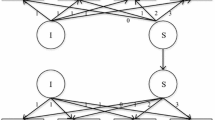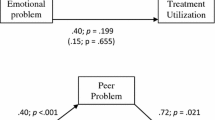Abstract
Residential treatment is arguably the most costly and intensive part of the children’s mental health system. Yet, research suggests that a subset of the emotionally disordered children and youth admitted to intensive tertiary care treatment facilities fail to demonstrate symptom reductions upon discharge, with many continuing to deteriorate in their adjustment during the follow-up period. This study reports on the factors that characterize the children and youth that, while showing marginal benefit from residential treatment, continue to show community conduct problems at a two-year follow-up period. The results are discussed in the context of how knowledge of these factors can help inform future treatment and research directions.
Similar content being viewed by others
References
Albano, A. M., Chorpita, B. F., & Barlow, D. H. (2003). Childhood anxiety disorders. In E. J. Mash & R. A. Barkley (Eds.), Child psychopathology (2nd ed., pp. 279–329). New York: Guilford Press.
Babinski, L. M., Hartsough, C. S., & Lambert, N. M. (1999). Childhood conduct problems, hyperactivity-impulsivity, and inattention as predictors of adult criminal activity. Journal of Child Psychology and Psychiatry and Allied Disciplines, 40(3), 347–355.
Bettmann, J. E., & Jasperson, R. A. (2009). Adolescents in residential and inpatient treatment: A review of the outcome literature. Child & Youth Care Forum, 38(4), 161–183.
Bierman, K. L., Coie, J. D., Dodge, K. A., Greenberg, M. T., Lochman, J. E., McMahon, R. J., et al. (2002). Using the Fast Track randomized prevention trial to test the early-starter model of the development of serious conduct problems. Developmental Psychopathology, 14(4), 925–943.
Birmaher, B., & Brent, D. (2005). Should we use antidepressants for the treatment of major depressive disorder in children and adolescents? Revista Brasileira de Psiquiatria, 27(2), 89–90.
Boyle, M. H., Cunningham, C., Georgiades, K., Cullen, J., Racine, Y., & Pettingill, P. (2009). The Brief Child and Family Phone Interview (BCFPI): 2. Usefulness in Screening for Child and Adolescent Psychopathology. Journal of Child Psychology and Psychiatry and Allied Disciplines, 50(4), 424–431.
Briggs-Gowan, M. J., Owens, P. L., Schwab-Stone, M. E., Leventhal, J. M., Leaf, P. J., & Horwitz, S. M. (2003). Persistence of psychiatric disorders in pediatric settings. Journal of the American Academy of Child and Adolescent Psychiatry, 42(11), 1360–1369.
Broidy, L. M., Nagin, D. S., Tremblay, R. E., Bates, J. E., Brame, B., Dodge, K. A., et al. (2003). Developmental trajectories of childhood disruptive behaviors and adolescent delinquency: A six-site, cross-national study. Developmental Psychology, 39(2), 222–245.
Casey, K. J., Reid, R., Trout, A. L., Duppong Hurley, K., Chmelka, M. B., et al. (2010). The transition status of youth departing residential care. Child & Youth Care Forum, 39(5), 323–340.
Cicchetti, D., & Rogosch, F. A. (2002). A developmental psychopathology perspective on adolescence. Journal of Consulting and Clinical Psychology, 70(1), 6–20.
Cunningham, C., Boyle, M. H., Hong, S., Pettingill, P., & Bohaychuk, D. (2009). The Brief Child and Family Phone Interview (BCFPI) 1: Rationale, Development, and Description of Computerized Children’s Mental Health Intake and Outcome Assessment Tool. Journal of Child Psychology and Psychiatry and Allied Disciplines, 50(4), 416–423.
Cunningham, C. E., Pettingill, P., & Boyle, M. H. (2004). The Brief Child and Family Phone Interview (BCFPI-3): A computerized intake and assessment tool. Interviewers manual.
Epstein, M. H., Kutash, K., & Duchnowski, A. (Eds.). (1998). Outcomes for children and youth with emotional and behavioral disorders and their families: Programs and evaluation best practices. Austin, TX: PRO-ED.
Fields, D., & Abrams, L. S. (2010). Gender differences in the perceived needs and barriers of youth offenders preparing for community reentry. Child & Youth Care Forum, 39(4), 253–269.
Fite, P. J., Stoppelbein, L., Greening, L., & Dhossche, D. (2008). Child internalizing and externalizing behavior as predictors of age at first admission and risk for repeat admission to a child inpatient facility. American Journal of Orthopsychiatry, 78(1), 63–69.
Frensch, K. M., & Cameron, G. (2002). Treatment of choice or a last resort? A review of residential mental health placements for children and youth. Child & Youth Care Forum, 31(5), 307–339.
Frensch, K., Cameron, G., & Preyde, M. (2009). Community adaptation of youth accessing residential programs or a home-based alternative: School attendance and academic functioning. Child & Youth Care Forum, 38(6), 287–303.
Goodyer, I. M., Herbert, J., Tamplin, A., Secher, S. M., & Pearson, J. (1997). Short-term outcome of major depression: II. Life events, family dysfunction, and friendship difficulties as predictors of persistent disorder. Journal of the American Academy of Child and Adolescent Psychiatry, 36(4), 474–480.
Hair, H. (2005). Outcomes for children and adolescents after residential treatment: A review of research from 1993 to 2003. Journal of Child and Family Studies, 14(4), 551–575.
Halliday-Boykins, C. A., Henggeler, S. W., Rowland, M. D., & Delucia, C. (2004). Heterogeneity in youth symptom trajectories following psychiatric crisis: Predictors and placement outcome. Journal of Consulting and Clinical Psychology, 72(6), 993–1003.
Hammen, C., & Rudolph, K. D. (2003). Childhood mood disorders. In E. J. Mash & R. A. Barkley (Eds.), Child psychopathology (2nd ed., pp. 233–278). New York: Guilford Press.
Henggeler, S. W., Rowland, M. D., Halliday-Boykins, C., Sheidow, A. J., Ward, D. M., & Randall, J. (2003). One-year follow-up of multisystemic therapy as an alternative to the hospitalization of youths in psychiatric crisis. Journal of the American Academy of Child and Adolescent Psychiatry, 42(5), 543–551.
Henggeler, S. W., Schoenwald, S., Borduin, C. M., Rowland, M. D., & Cunningham, P., I. I. (2009). Multisystemic therapy for antisocial behavior in children and youth. New York, NY: The Guilford Press.
Hodges, K. (2000). Child and adolescent functional assessment scales (2nd revision). Ypsilanti, Michigan: Eastern Michigan University.
Kessler, R. C., Foster, C. L., Saunders, W. B., & Stang, P. E. (1995). Social consequences of psychiatric disorders, I: Educational attainment. American Journal of Psychiatry, 152(7), 1026–1032.
Kjelsberg, E. (1999). A long-term follow-up study of adolescent psychiatric in-patients. Part IV. Predictors of a non-negative outcome. Acta Psychiatrica Scandinavica, 99(4), 247–251.
Lavigne, J. V., Arend, R., Rosenbaum, D., Binns, H. J., Christoffel, K. K., & Gibbons, R. D. (1998). Psychiatric disorders with onset in the preschool years: I Stability of diagnoses. Journal of the American Academy of Child and Adolescent Psychiatry, 37(12), 1246–1254.
Leschied, A. W., Chiodo, D., Nowicki, E., & Rodger, S. (2008). Childhood predictors of adult criminality: A meta-analysis drawn from the prospective longitudinal literature. Canadian Journal of Criminology and Criminal Justice, 50(4), 435–467.
Marsh, S. C., Evans, W. P., & Williams, M. J. (2010). Social support and sense of program belonging discriminate between youth-staff relationship types in juvenile correction settings. Child & Youth Care Forum, 39(6), 481–494.
McMahon, R. J. (1994). Diagnosis, assessment, and treatment of externalizing problems in children: The role of longitudinal data. Journal of Consulting and Clinical Psychology, 62(5), 901–917.
Moffitt, T. E. (1993). Adolescence-limited and life-course-persistent antisocial behavior: A developmental taxonomy. Psychological Review, 100(4), 674–701.
Moffitt, T. E., & Caspi, A. (2001). Childhood predictors differentiate life-course persistent and adolescence-limited antisocial pathways among males and females. Developmental Psychopathology, 13(2), 355–375.
Moffitt, T. E., Caspi, A., Harrington, H., & Milne, B. J. (2002). Males on the life-course-persistent and adolescence-limited antisocial pathways: Follow-up at age 26 years. Developmental Psychopathology, 14(1), 179–207.
Renaud, J., Brent, D. A., Baugher, M., Birmaher, B., Kolko, D. J., & Bridge, J. (1998). Rapid response to psychosocial treatment for adolescent depression: A two-year follow-up. Journal of the American Academy of Child and Adolescent Psychiatry, 37(11), 1184–1190.
Rubin, K. H., Burgess, K. B., Kennedy, A. E., & Stewart, S. L. (2003). Social withdrawal in childhood. In E. J. Mash & R. A. Barkley (Eds.), Child psychopathology (2nd ed., pp. 372–406). New York: Guilford Press.
Rubin, K. H., & Stewart, S. L. (1996). Social withdrawal. In E. J. Mash & R. A. Barkley (Eds.), Child psychopathology (1st ed., pp. 277–307). New York: Guilford Press.
Ruchkin, V., Koposov, R., Vermeiren, R., & Schwab-Stone, M. (2003). Psychopathology and age at onset of conduct problems in juvenile delinquents. Journal of Clinical Psychiatry, 64(8), 913–920.
Ruchkin, V. V., Schwab-Stone, M., Koposov, R., Vermeiren, R., & Steiner, H. (2002). Violence exposure, posttraumatic stress, and personality in juvenile delinquents. Journal of the American Academy of Child and Adolescent Psychiatry, 41(3), 322–329.
Rutter, M. (2004). The promotion of resilience in the face of adversity. In A. Clarke-Stewart & J. Dunn (Eds.), Families count: Effects on child and adolescent development (pp. 26–52). New York: Cambridge University Press.
Schelble, J. L., Franks, B. A., & Miller, M. D. (2010). Emotion dysregulation and academic resilience in maltreated children. Child & Youth Care Forum, 39(4), 289–303.
Shabat, J. C., Lyons, J. S., & Martinovich, Z. (2008). Exploring the relationship between conduct disorder and residential treatment outcomes. Journal of Child and Family Studies, 17(3), 353–371.
Speltz, M. L., McClellan, J., DeKlyen, M., & Jones, K. (1999). Preschool boys with oppositional defiant disorder: Clinical presentation and diagnostic change. Journal of the American Academy of Child and Adolescent Psychiatry, 38(7), 838–845.
St. Pierre, J., Leschied, A. W., Stewart, S. L., & Cullion, C. M. (2008). Differentiating three-year outcomes following tertiary child and youth inpatient psychiatric treatment. Final report to the Centre of Excellence for Child and Youth Mental Health at the Children’s Hospital of Eastern Ontario.
Stewart, S. L., Hirdes, J., Perlman, C., Currie, M., & Siman, E. (2010). An examination of criminal behaviour in youth admitted to adult psychiatric beds using the MDS-MH. Paper presented at the Canadian InterRAI Conference.
Tremblay, R. E., Nagin, D. S., Seguin, J. R., Zoccolillo, M., Zelazo, P. D., Boivin, M., et al. (2004). Physical aggression during early childhood: Trajectories and predictors. Pediatrics, 114(1), e43–e50.
van Lier, P. A., Wanner, B., & Vitaro, F. (2007). Onset of antisocial behavior, affiliation with deviant friends, and childhood maladjustment: A test of the childhood- and adolescent-onset models. Developmental Psychopathology, 19(1), 167–185.
Vermeiren, R., Jespers, I., & Moffitt, T. (2006). Mental health problems in juvenile justice populations. Child and Adolescent Psychiatric Clinics of North America, 15(2), 333–351. vii–viii.
Vermeiren, R., Schwab-Stone, M., Ruchkin, V., De Clippele, A., & Deboutte, D. (2002). Predicting recidivism in delinquent adolescents from psychological and psychiatric assessment. Comprehensive Psychiatry, 43(2), 142–149.
World Health Organization. (2003). Caring for children and youth with mental disorders. Retrieved June 28, 2010. from http://www.who.int/mental_health/media/en/785.pdf.
Conflict of Interest
Initial funding for this study was provided by the Centre of Excellence in Children’s Mental Health of the Children’s Hospital of Eastern Ontario, Ottawa Ontario.
Author information
Authors and Affiliations
Corresponding author
Rights and permissions
About this article
Cite this article
Cuthbert, R., Pierre, J.S., Stewart, S.L. et al. Symptom Persistence in Seriously Emotionally Disordered Children: Findings of a Two-Year Follow-up after Residential Treatment. Child Youth Care Forum 40, 267–280 (2011). https://doi.org/10.1007/s10566-010-9137-z
Published:
Issue Date:
DOI: https://doi.org/10.1007/s10566-010-9137-z




